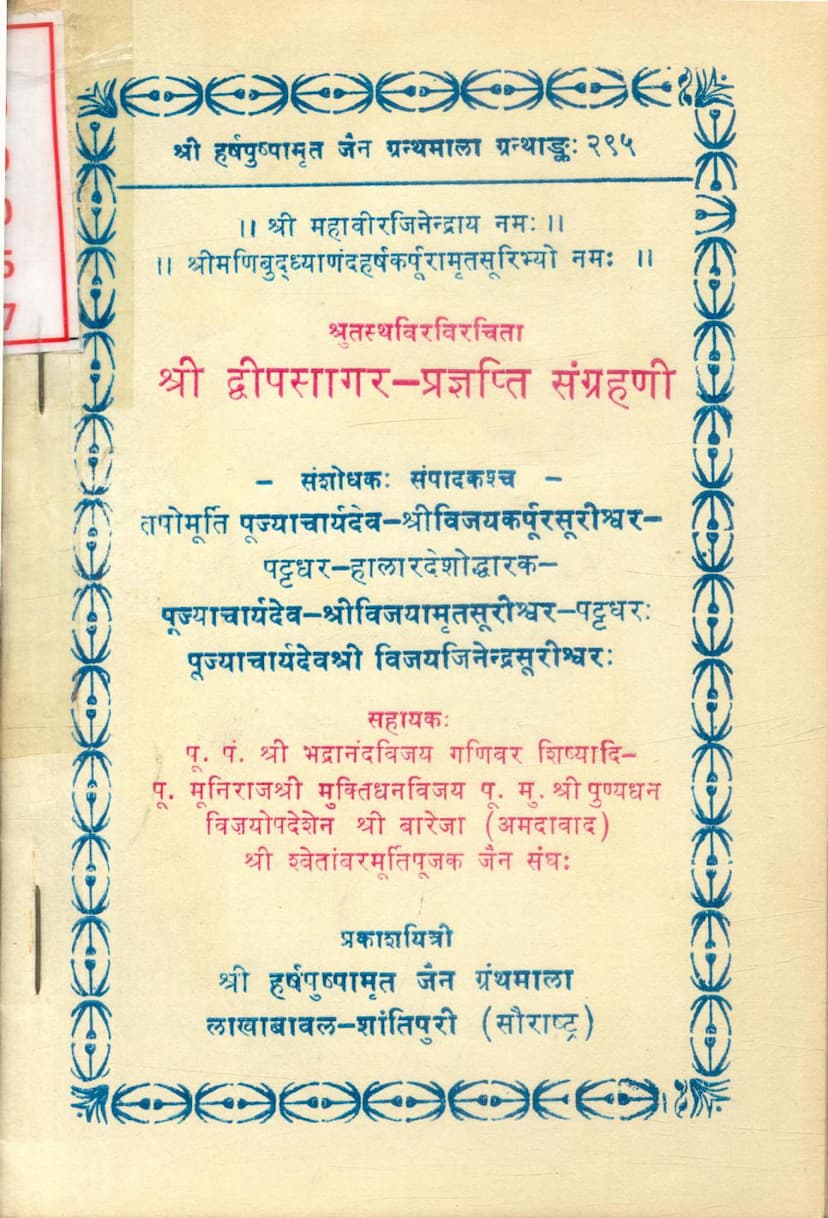Dwipsagar Pragnapti Sangrahani
Added to library: September 1, 2025

Summary
Here is a comprehensive summary of the Jain text "Dwipsagar Pragnapti Sangrahani" by Vijayjinendrasuri, based on the provided pages:
Book Title: Dwipsagar Pragnapti Sangrahani (also referred to as Sri Dwip Sagar Pannatti Sanghayani) Author: Shrutsamviravirachita (composed by ancient scholars) Editor/Compiler: Acharya Dev Shri Vijay Karpur Surishwar, under the patronage of Acharya Dev Shri Vijay Jinendrasurishwar. Publisher: Shri Harshpushpamrut Jain Granthmala, Lakhabaal-Shantipur (Saurashtra) Catalog Link: https://jainqq.org/explore/022610/1
Overall Purpose: This text is a "Sangrahani," which means a compilation or collection. It serves as a systematic summary and compilation of the cosmological descriptions found in Jain scriptures, specifically focusing on the various continents (Dwips) and oceans (Sagars) of the Jain universe. The primary aim is to present this detailed knowledge in an organized and accessible manner.
Content Overview: The "Dwipsagar Pragnapti Sangrahani" elaborates on the geography of the Jain cosmos beyond the human realm (Manushyakshetra). It details the structure, dimensions, features, and inhabitants of various celestial islands and the oceans that separate them. The text is presented in Prakrit verses, with the provided excerpt beginning to describe the Manushyottar Parvat (Manushyottar Mountain).
Key Sections and Concepts Covered (Based on the provided pages):
-
Manushyottar Parvat (Manushyottar Mountain):
- This is the first geographical feature discussed, marking the boundary of the human continent.
- It is described as being circular and enclosing the human realm.
- Detailed measurements are given for its height, width at the base, middle, and top.
- The mountain is adorned with numerous peaks (Kutas) located in cardinal and intercardinal directions, named after various precious gems (e.g., Veruliyam, Ajnag, Kanaka, Ratna).
- The text mentions the lifespan of beings residing there and the precious materials they are made of.
-
Dwips (Continents/Islands) and Sagars (Oceans):
-
The text proceeds to describe several other significant Dwips and the oceans surrounding them.
-
Nalinodaka, Surarama, Ksheeravara, Ghritasagara, Kshodhavara: These are mentioned as oceans with specific dimensions and absence of "Gotirthas" (sacred places or routes).
-
Nandishwar Dwip: A significant island, detailed with its circumference and the presence of Ajnanaga mountains.
- Ajnanaga Mountains: These are described as being adorned with precious stones and housing temples of the Arhats.
- Temples (Ayatanas): These are central to the description of the mountains, indicating the presence of divine beings and worship.
- Gardens (Vanashanda): Surrounding the Ajnanaga mountains, these gardens are named after various trees (Ashoka, Saptavarna, Champa, Mango) and are protected by walls.
- Pushkarinis (Ponds/Lakes): Found within these gardens, they are described with their dimensions and names.
- Dahimukha (curd-like streams): Flowing from the ponds, named after curd and milk, and also featuring temples.
- Residential Cities (Rajadhani): Various cities belonging to celestial beings (Devas) are described, often located around the mountains.
- Residential Cities of Sakra and Ishana: Specific descriptions of the cities of the kings of the respective celestial regions (Sakra is the king of the first heaven, Ishana is the king of the second).
-
Kundal Dwip:
- This island is also characterized by a central mountain, Kundala.
- Detailed measurements for the mountain's height, width, and circumference are provided.
- Numerous gem-adorned peaks surround the central mountain, with specific names.
- The cities of celestial beings, particularly those belonging to the Ishana and Sakra regions, are described.
-
Ruchak Dwip:
- This island is also circular, with a central mountain named Ruchak.
- Again, the text provides extensive details about the dimensions of the mountain and its numerous peaks.
- The peaks are named after precious gems and metals.
- The text mentions the dwelling places of specific types of celestial beings (e.g., Disakumaris) on these peaks.
- The cities and palaces of the celestial rulers and their consorts are described.
- The text mentions the presence of "Chetya Vrikshas" (sacred trees) and Jin temples.
-
Shankhvar Dwip:
- This island is mentioned, with its inhabitants being celestial beings.
- The text briefly touches upon the fact that beyond these described islands, there are innumerable other islands and oceans with similar names and celestial rulers.
-
Arun Dwip and Arunodaka Sagar:
- These are described after Ruchak Dwip.
- Detailed dimensions are given for Arun Dwip and the Arunodaka Sagar.
- The text mentions the presence of the "Tegichhi" (celestial beings) and their residences, which are made of various precious stones.
- The text describes the cities and palaces, including specific details about their construction, adornments, and the celestial beings residing in them.
- It details the celestial chariots (Vimanas) and the celestial beings associated with them.
- The text describes the celestial Sun and Moon (Chandra-Surya) and their paths.
-
Structure and Style:
- The text is written in Prakrit, a language common in ancient Jain literature.
- It uses a metrical structure (verses are referred to by number, e.g., verse 1, verse 2).
- The style is descriptive and quantitative, providing precise measurements and names for geographical features and celestial abodes.
- The "Sangrahani" aspect means it consolidates information that might be scattered across various other Jain scriptures.
Significance: This text is a crucial source for understanding the elaborate cosmology of Jainism. It provides a detailed map of the universe as envisioned by the Jains, including the locations of heavens, celestial beings, and sacred sites. It serves as a foundational text for Jain cosmology and geographical studies.
In summary, the "Dwipsagar Pragnapti Sangrahani" is a systematic and detailed cosmological treatise that meticulously describes the dimensions, structures, and inhabitants of the various continents and oceans within the Jain universe, extending beyond the human realm. It is a compilation of ancient Jain knowledge presented in Prakrit verses, offering a comprehensive account of celestial geography.